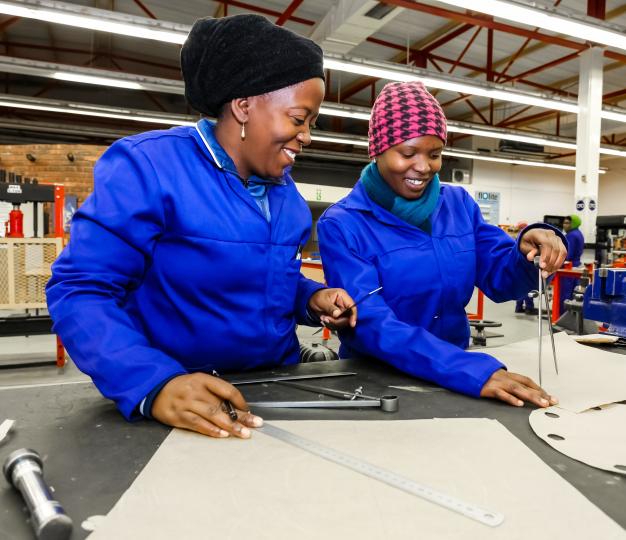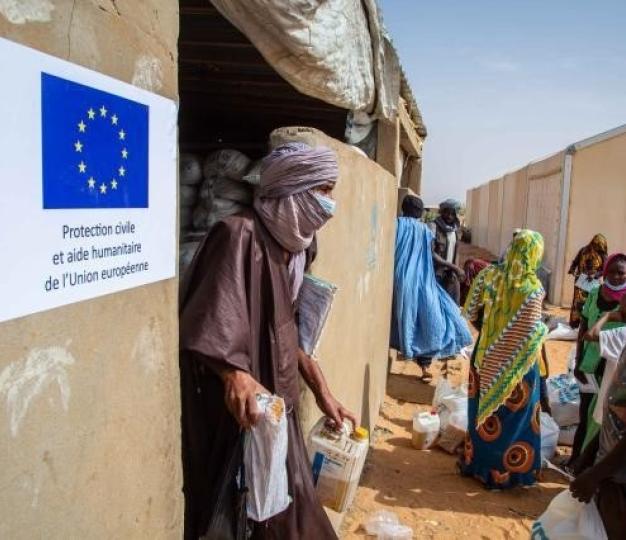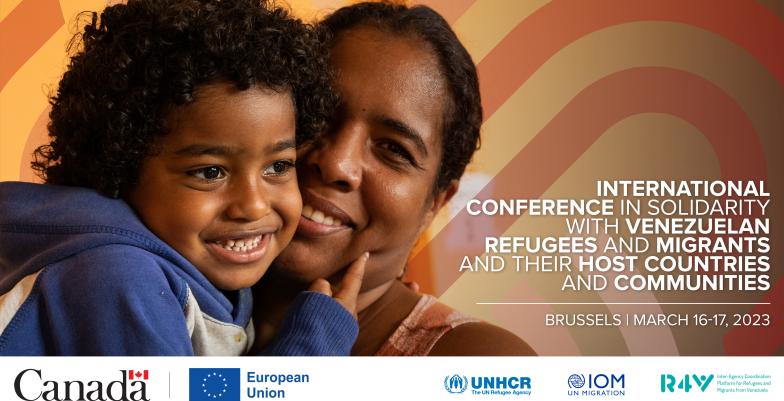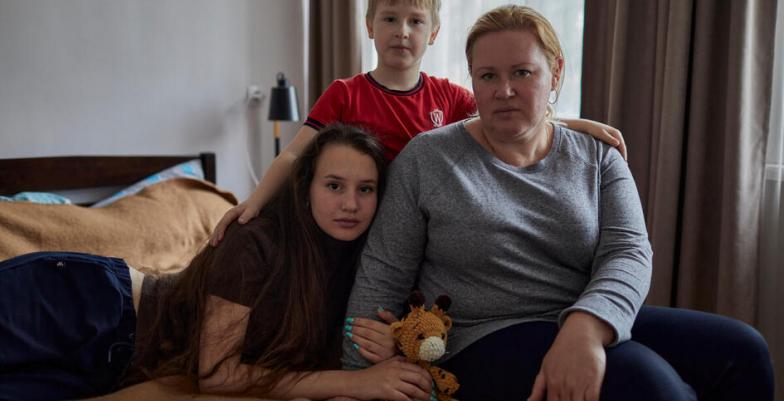Migration, Mobility & Forced Displacement
Worldwide people are on the move. The number of international migrants has grown consistently over the last 20 years. 27.3 million non-EU country citizens were residing in EU Member States as of early 2024, representing 6 % of the EU population. The majority of international migrants in the EU come for family reasons (34%), work (21%) or study (4%).
Migration & Mobility
Migration is the movement of persons away from their place of usual residence, within a country or across an international border, temporarily or permanently. Around the world, the vast majority of migrants travel, live and work in a regular and legal manner. Migration can bring considerable benefits to all sides. In countries of destination, migrants can make up for labour shortages, invest in new businesses, help create jobs and contribute to a richer and more diverse culture.
Migration also contributes to development in countries of origin: migrants send home remittances, which provide a stable source of financing that can help reduce poverty, and bring home new skills.
While the vast majority of migrants arrive in Europe through regular migration channels, migration can present challenges, when it takes place in an irregular manner. Migrants risk their life on dangerous journeys and are vulnerable to exploitation and abuse. At their destination, irregular migrants often face difficulties in accessing health care, housing, education or employment. Organised crime networks benefit from facilitating irregular migration through smuggling and trafficking.
Migration is therefore a key policy area for the EU. Over the past years, the EU has developed a comprehensive and balanced policy framework on migration. Our ultimate aim is to ensure that migration takes place in a safe, orderly and legal manner, avoiding loss of life, protecting the human rights of migrants and providing international protection to those who need it. Constructive and sustainable migration policies are in the interest of partner countries, the EU, and refugees and migrants themselves.
The Pact on Migration and Asylum
In 2024, the Council of the European Union adopted the Pact on Migration and Asylum. The Pact contains a set of new rules managing migration and establishing a common asylum system in the EU. EU Member States have two years (until June 2026) to implement the Pact in full.

European Union, 2025
The EU Pact on Migration and Asylum will strengthen and integrate key EU policies on migration, asylum, border management and integration. New legislative rules aim at creating a fairer, more efficient and more sustainable migration and asylum process in the EU.
Whilst much of the Pact is about reforming the EU’s asylum and migration systems, the Pact also puts great emphasis on the external dimension, in particular on cooperation with third countries and regions, acknowledging that migration is central to the EU’s overall relationships with key partner countries of origin and transit.
International partnerships
The New Pact foresees to strengthen tailor-made, comprehensive and mutually beneficial partnerships with key third countries of origin and transit. In such comprehensive partnerships, migration should be built in as a core issue, based on an assessment of the interests of the EU and partner countries.
These partnerships can cover all relevant aspects of migration and forced displacement, with the primary objectives to prevent irregular departures and loss of life, fight migrant smuggling and trafficking in human beings, reinforce cooperation on readmission and promote legal pathways. The European Union remains committed to providing support for refugees and displaced people and their host communities and will continue to work with international partners to address the root causes of irregular migration and forced displacement, and to strengthen migration governance and management in partner countries.
Working with our international partners
The EU engages continuously with partner countries in the framework of comprehensive migration dialogues.
At multilateral levellevel, the EU works closely with key UN agencies, such as the UN High Commissioner for Refugees (UNHCR), the International Organisation for Migration (IOM) or the UN Office on Drugs and Crime (UNODC).
Regional processes are valuable frameworks for dialogue that facilitate practical exchanges of experiences and perspectives from countries of origin, transit and destination, and help enhancing mutual understanding of approaches to migration-related challenges and opportunities. The EU is actively engaged in the Rabat, Khartoum, Budapest and Prague processes that cover the various migration routes to Europe. The Joint Valletta Action Plan continues to provide a useful framework for the EU's work on migration, notably though its principles of solidarity, shared responsibility and partnership and its comprehensive and balanced approach to migration.
Relevant EU agencies also work with partners beyond the EU’s borders. FRONTEX has a significant presence in the Balkans and has concluded working arrangements with nineteen non-EU countries to jointly address migration and border security challenges. The EU Asylum Agency (EUAA) provides capacity-building programmes in third countries and has established roadmaps for bilateral cooperation with a number of partner countries. EUROPOL, the EU’s law enforcement agency has concluded working and operational agreements with several non-EU countries to step up cooperation in the fight against transnational, serious and organised crime including migrant smuggling and trafficking in human beings. Eurojust concludes working arrangements with third countries, as well as with international organisations and judicial networks and associations established outside of the EU to enable closer cooperation in combatting serious crime on a strategic level.
Continental dialogue
The African Union – European Union Continent-to-Continent Dialogue on Migration and Mobility was launched at the 5th AU-EU Summit in Abidjan in November 2017. The continental dialogue expands the exchange of best practices and sharing of information to the African continent as a whole.
Migration and Development
The 2030 Agenda for Sustainable Development recognises that migration is a powerful driver of sustainable development, for migrants and their communities.
Sustainable development
At EU level, the European Consensus on Development (2017) mirrors the UN 2030 Agenda and acknowledges both the challenges and the opportunities migration brings for inclusive growth and sustainable development when well-managed.
Through remittances migrants make major contributions to development and poverty reduction at home. Globally, remittance flows are estimated to have increased from USD 865 billion in 2023 to USD 905 billion in 2024, three times the Official Development Assistance (USD 212.1 billion in 2024).
Remittance flows tend to be stable and resilient during crises. The EU is working with partners to promote cheap, fast and reliable remittance transfers.
Addressing root causes of irregular migration
The reasons why people decide to migrate are complex, and may range from conflict, to environmental disasters, poverty or the search for economic opportunities. Often these migration drivers are influenced and enhanced by each other.
The vast majority of migrants undertake their journeys in a regular and safe manner. Those migrants who embark on irregular routes often become victim of smugglers and traffickers, face exploitation and put their lives and dignity at risk on their often dangerous journeys.
The EU therefore works with partner countries to address the root causes of irregular migration and in many countries runs campaigns to inform potential migrants about risks related to irregular migration and available legal alternatives. Through its international cooperation, the EU supports countries in improving socioeconomic and job opportunities, and invests in education and the development of skills that match the needs of the job markets in both home and destination countries to facilitate legal migration and labour mobility.
Migration & Labour Mobility
Legal migration is not only an essential element to counter irregular migration, it also brings considerable benefit to our society and can be an important driver for economic growth. Given the demographic trends and ageing societies in Europe, the EU’s prosperity in the coming years will also depend on the Union’s ability to attract skills and talent from non-EU countries. In his 2024 Report on the Future of European Competitiveness, former European Central Bank President Mario Draghi highlighted the urgent need for the EU to attract talent from abroad. The 2025 Union of Skills Communication of the European Commission recognises this need to attract, develop and retain talent as crucial preconditions for innovation, growth and competitiveness.
The EU therefore works on measures to boost mutually beneficial labour mobility between the EU and partner countries. As part of the Pact of Migration and Asylum, the EU presented the “EU Talent Pool”, a digital platform that will help European employers to recruit talent from outside the EU. The EU also works on a new visa strategy, to make it easier for top students, skilled workers and researchers to come to the EU.
Talent Partnerships
The EU launched Talent Partnerships to enhance legal pathways to the EU. So far, Talent Partnerships were established with Egypt, Morocco, Tunisia, Pakistan and Bangladesh. Talent Partnerships aim to provide a comprehensive policy framework as well as funding to boost mutually beneficial international mobility based on better matching of labour market needs and skills between the EU and partner countries.
Against migrant smuggling
The EU is taking decisive action against migrant smuggling that is a profitable business for criminal networks with an estimated annual turnover reaching multiple billion euros worldwide.
Migrant smuggling is increasingly associated with serious human rights violations and deaths, in particular when it occurs by sea. As announced in the Pact on Migration and Asylum and the EU Security Union Strategy, the Commission has adopted a renewed EU action plan against migrant smuggling for the period 2021-2025. In November 2023, the EU proposed a package of innovative legislation to prevent and fight migrant smuggling and initiated a new Global Alliance to counter migrant smuggling.
Return, Readmission and Sustainable Reintegration
An effective and well-managed return system is an essential part of a comprehensive migration and asylum policy. The EU is promoting wider and better use of voluntary return and reintegration to ensure humane, effective, and sustainable return of persons with no legal right to stay in the EU.
On the external dimension, the Commission is engaging with third countries on improving cooperation on readmission, including in the context of comprehensive partnerships. The Commission regularly monitors cooperation in the framework of the existing bilateral and multilateral readmission instruments and through the annual assessment on readmission cooperation under Article 25a of the Visa Code.
Returnee reintegration
The EU provides support to the sustainable reintegration of returnees taking into account the social, psychosocial and economic aspects of the person's return to the community of origin. Sustainable reintegration aims at supporting not only individuals, but also the structures and services that make reintegration possible in the country of return, such as job search, education and training.
This in turn benefits the whole community, and could help address the reasons that would have led the migrants to leave in the first place.
Readmission agreements
To facilitate the readmission of third country nationals, the EU has concluded legally binding Readmission Agreements with 15 partner countries. They set out clear obligations and procedures for the authorities of the partner country and of EU Member States as to when and how to return migrants who have no right to stay in the EU.
In addition, legally non-binding readmission arrangements have been concluded with six countries.
Forced Displacement
By end of June 2024, 122.6 million people were displaced worldwide, according to UNHCR's 2024 Mid-Year Trends analyses. They are forced to leave their homes due to conflict, violence, human rights violations, persecution, and natural hazards.
This number reached the 100 million mark in the first half of 2022 due to the Russian aggression against Ukraine – the highest number ever recorded.
Of all forcibly displaced people, 70.88 million are internally displaced people and 43.7 million are refugees (as of mid-2024). 87% of the world’s refugees and other people in need of international protection are hosted by low and middle-income countries. An estimated 47 million are children below the age of 18.
In (year), the majority of refugees and other people in need of international protection come from just four countries: the Syrian Arab Republic (6.3 million), Venezuela (6.2 million), Ukraine (6.1 million) and Afghanistan (6.1 million). Iran is the largest refugee-hosting country in the world (around 3.8 million refugees), followed by Türkiye (around 3.1 million), Colombia (2.8 million), Germany (around 2.7 million), and Uganda (around 1.7 million).
In 2024, the European Union received around one million refugees and 4.3 million beneficiaries of temporary protection who fled Ukraine following Russia’s invasion.
Protection
The 1951 Convention relating to the Status of Refugees (Geneva Convention) provides the international legal framework for refugee protection. It recognises that a satisfactory solution to refugee situations requires international cooperation. Against this background, the 2019 UNHCR Global Compact on Refugees intends to provide a basis for predictable and equitable burden- and responsibility-sharing among all United Nations Member States, together with other relevant stakeholders.
The Global Compact emanates from fundamental principles of humanity and international solidarity, and seeks to operationalise the principles of burden- and responsibility-sharing to better protect and assist refugees and support host countries and communities.
It is grounded in the international refugee protection regime, centred on the cardinal principle of non-refoulement. The EU has actively contributed to the development of the Compact and is engaged in its practical implementation.
Common global challenge
The EU is committed to meeting this common global challenge in a spirit of partnership and will continue to work on strengthening protection systems, protection capacities, and access to international protection within Europe and in partner countries hosting refugees.
Refugees' support
Together with its Member States, the EU is the leading donor to support responses to major refugee crises, bringing together humanitarian and development efforts through the EU policy on forced displacement.
The EU allocated most of its humanitarian budget of EUR 1.9 billion for 2025 to address the needs of refugees, IDPs and their host communities.
The EU has given considerable support to refugee hosting countries, notably to the countries affected by the Syria crisis through dedicated instruments such as the EU's Facility for Refugees in Turkey and the EU Regional Trust Fund in Response to the Syrian crisis.
In addition, the humanitarian evacuation of people from Libya to Emergency Transit Mechanisms in Niger and Rwanda for onward resettlement helps the most vulnerable.
In the context of the war in Ukraine, the Commission allocated since 2022 EUR 1.090 billion for humanitarian aid programmes.
In response to the conflict in Gaza, in 2024, the European Commission has significantly increased its humanitarian assistance to Palestine, allocating €237 million in humanitarian aid to vulnerable Palestinians in Gaza and the West Bank.
In 2025, the Commission announced an initial €120 million in humanitarian aid to vulnerable Palestinians.
A Humanitarian Air Bridge operation continues to provide aid to the civilians affected by the crisis.
Resettlement
Resettlement provides protection to the most vulnerable refugees by admitting them into an EU country where they will be able to access protection. It is a safe and legal alternative to irregular journeys and a demonstration of European solidarity with non-EU countries hosting large numbers of persons fleeing war or persecution.
Resettlement is based on referrals by the UNHCR. Since 2015, three successful EU-sponsored resettlement schemes have helped more than 130,000 of the most vulnerable people in need of international protection find shelter in the EU.
The Union Resettlement and Humanitarian Admission Framework Regulation, adopted in May 2024 as part of the Pact on Migration and Asylum, sets a permanent framework and common procedures to enhance safe and legal pathways to protection in the EU.
Under the 2024-2025 EU Resettlement and Humanitarian admission scheme, 14 EU countries provided 61,000 pledges for resettlement and humanitarian admission.
Funding
Under the 2021-2027 programming framework the EU’s external financing instruments, for the first time, explicitly target support towards migration.
The NDICI-Global Europe Regulation is a key tool to support the implementation of the New Pact on Migration and Asylum stressing the importance of building comprehensive, mutually beneficial partnerships with third countries on migration in line with the priorities for external cooperation: protecting those in need and supporting host countries; building economic opportunities and addressing root causes of irregular migration; forging partnerships to strengthen migration governance and management; fostering cooperation on readmission and reintegration; and developing legal pathways to Europe.
Indicatively 10 % of the financial envelope for the NDICI-Global Europa Instrument is dedicated to actions supporting management and governance of migration and forced displacement within the objectives of the Instrument. The target also includes actions to address the root causes of irregular migration and forced displacement when they directly target specific challenges related to migration and forced displacement.
Migration funding may be complemented from other Instruments such as e.g. Pre-Accession Assistance (IPA III).











